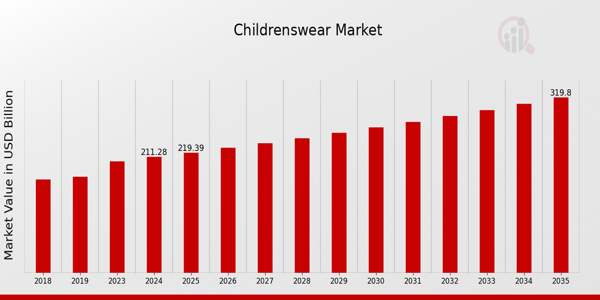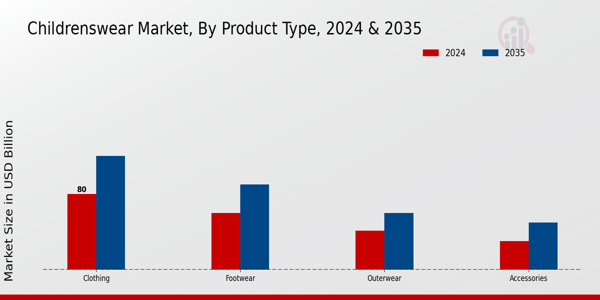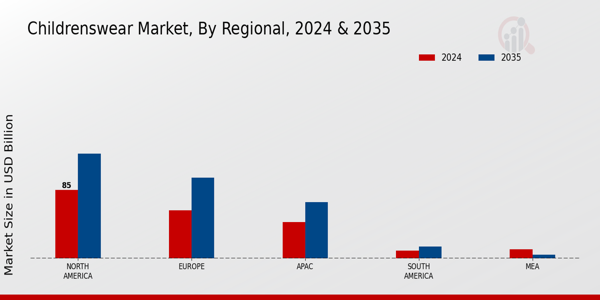Childrenswear Market Overview
Childrenswear Market Size was estimated at 203.47 (USD Billion) in 2023.The Childrenswear Market Industry is expected to grow from 211.28(USD Billion) in 2024 to 320 (USD Billion) by 2035. The Childrenswear Market CAGR (growth rate) is expected to be around 3.84% during the forecast period (2025 - 2035).

Source: Primary Research, Secondary Research, MRFR Database and Analyst Review
The global childrenswear market is undergoing significant change as a result of a number of significant factors. The growing emphasis on sustainability is one noteworthy trend. Brands are adopting eco-friendly materials and production methods as a result of consumers' growing awareness of the environmental effect of their purchases.
Furthermore, there is a rising demand for apparel that is ethically and organically sourced, which is pushing producers to develop collections that reflect these ideals. The expansion of e-commerce platforms and the increase in disposable incomes are important market factors.
In order to meet the growing demand for fashionable and high-quality childrenswear, businesses are increasing their online presence. Parents may evaluate alternatives and make well-informed selections from the comfort of their homes thanks to the internet's handy purchasing experience.
Furthermore, as parents frequently look for popular products for their kids based on internet trends, social media and celebrity endorsements have a big impact on consumer behavior. There are chances to grow product lines that target certain age groups and specialized markets, such inclusive sizing or adaptable apparel for kids with impairments.
Brands may set themselves apart by capturing these segments. Additionally, customers searching for distinctive things for their kids are drawn to the market's trend toward personalized and customized apparel.
These and other trends point to a dynamic and changing global childrenswear market, fueled by shifting consumer tastes and technology breakthroughs. The industry is in a strong position to expand as it adjusts to the requirements and preferences of contemporary families.

Source: Primary Research, Secondary Research, MRFR Database and Analyst Review
The rise in disposable income across the globe has been a significant driver for the Global Childrenswear Market. As families experience greater purchasing power, spending on childrenswear is expected to increase.
According to World Bank data, global household disposable income has witnessed a steady rise, with an average increase of around 4.5% annually over the last decade. This economic trend is particularly pronounced in emerging markets where parents are more willing to invest in quality clothing for their children, focused on durability and style.
Established organizations such as UNICEF have reported that improved economic conditions lead to better education and health outcomes for children, making parents more inclined to spend on children's apparel. This trend indicates that as disposable incomes rise, so will the demand for fashionable and functional childrenswear globally.
Growing Influence of E-commerce and Online Shopping
The rapid expansion of e-commerce platforms has revolutionized how consumers purchase childrenswear, significantly impacting the Global Childrenswear Market. A report by the United Nations Conference on Trade and Development noted that global online retail sales grew by 25% in 2020, highlighting a shift toward digital shopping.
Major online retailers, such as Amazon and Alibaba, invest heavily in inventory for children’s clothing while also providing parents with a larger selection and easier access to competitive pricing.
Additionally, the ease of online shopping during the COVID-19 pandemic has solidified its popularity among parents looking for convenience. The significant increase in online shopping frequency indicates that more consumers will continue to prefer e-commerce for purchasing children’s apparel, further propelling market growth.
Rising Awareness about Sustainable and Eco-friendly Fashion
There is a growing consumer preference for sustainable and eco-friendly childrenswear, which is shaping the Global Childrenswear Market. According to a survey by the Global Fashion Agenda, 75% of consumers expressed a desire to buy sustainable clothing, indicating a shift in buying habits.
Companies like Patagonia and H&M are leading the way by integrating sustainable practices in their children’s clothing lines, promoting both environmental responsibility and quality.
This sentiment is also reflected in policies from various governments urging the fashion industry to adopt sustainable practices, reinforced by the European Commission's ongoing initiatives focused on promoting sustainability in fashion. As awareness around the environmental impact of fast fashion rises, the demand for eco-friendly options in childrenswear is expected to drive significant growth in the market.
Childrenswear Market Segment Insights
Childrenswear Market Product Type Insights
The Global Childrenswear Market showcases a diverse range of product types that drive significant revenue. The market segmentation reveals four key categories: Clothing, Footwear, Accessories, and Outerwear, each contributing uniquely to the industry landscape.
Clothing held a predominant position, valued at 100.0 USD Billion in 2024 and rising to 155.0 USD Billion in 2035, which indicated its majority holding in the market. This can be attributed to growing fashion consciousness among parents and children, highlighting the importance of apparel in expressing identity and style.
Footwear followed closely, expected to expand from a valuation of 60.0 USD Billion in 2024 to 95.0 USD Billion in 2035. With an upsurge in active play and outdoor activities, the demand for durable and stylish footwear continues to be a significant growth driver.
Accessories, projected to grow from 30.0 USD Billion in 2024 to 45.0 USD Billion in 2035, although less dominant, added value through personalization and trend-driven offerings, appealing to both children and parents.
Lastly, Outerwear, valued at 21.28 USD Billion in 2024 and anticipated to rise to 25.0 USD Billion in 2035, played a crucial role in seasonal apparel needs, with its significance increasing in regions with harsh climates.
The Global Childrenswear Market data suggested a clear opportunity for brands to capitalize on these trends by focusing on quality and style in each product type to meet the evolving preferences of young consumers and their parents.
The overall market growth was propelled by factors such as rising disposable incomes, increasing awareness about fashion trends, and the desire for high-quality products among parents, while challenges such as competition and pricing pressure also persist. The Global Childrenswear Market statistics reflected not only a vibrant industry but also the notable segmentation that shapes its overall dynamics.
Childrenswear Market Age Group Insights
The Global Childrenswear Market emphasizes various age groups within the segment, including Infants, Toddlers, Preschoolers, and Kids. Each of these groups holds significant importance in the market dynamics. Infants typically dominate due to the constant demand for clothing as they quickly outgrow their garments.
Toddlers also represent a substantial portion of the market, driven by parents' willingness to invest in comfort and safety. Preschoolers’ clothing trends often reflect popular culture and developmental needs, while Kids’ apparel focuses on fashion and individuality, making it a highly competitive segment within the market.
As families prioritize quality and sustainability in children's clothing, companies are responding with eco-friendly product lines, reflecting shifts in consumer preferences. The Global Childrenswear Market revenue benefits from growing awareness of children’s fashion and the influence of social media on shopping behaviors.
Overall, the segmentation by age group not only delineates market strategies but also highlights the evolving trends driven by changing societal norms and values surrounding childcare and parenting.
Childrenswear Market Gender Insights
The Global Childrenswear Market exhibits significant segmentation based on gender. This segmentation includes categories for Boys, Girls, and Unisex, each playing a vital role in shaping the industry dynamics. The Boys segment continues to dominate due to the consistent demand for durable and multifunctional clothing, a reflection of active lifestyles among younger males.
Conversely, the Girls segment has seen a growing trend towards fashion-forward clothing that emphasizes individuality and personal expression. Unisex clothing also reflects a significant shift in consumer preferences, resonating with the demand for gender-neutral options that appeal to parents seeking versatility.
The emphasis on sustainability and ethical production practices has become a driving force in these segments, influencing consumer purchasing decisions and encouraging brands to innovate.
With the projected growth path, the Global Childrenswear Market presents opportunities for brands to invest in diversified designs and eco-friendly practices, aligning with global consumer trends and values surrounding childhood apparel.
Childrenswear Market Sales Channel Insights
The Global Childrenswear Market showcases a dynamic Sales Channel landscape that has evolved significantly in recent years. As per Global Childrenswear Market data, Online Stores have gained substantial traction, driven by convenience and a growing preference for e-commerce among parents, allowing them to easily browse and purchase from a vast selection.
Conversely, Brick-and-Mortar Stores continue to hold a significant presence, offering tactile shopping experiences and immediate product access, which many consumers still value for children's clothing. Department Stores also play a crucial role, often serving as one-stop shops for various brands, attracting families seeking diverse options for kids' apparel.
The interplay of these channels reflects a blend of traditional and modern shopping behaviors, presenting ongoing opportunities for growth as the Global Childrenswear Market continues to evolve in response to consumer demands and market trends.
The expected growth in this segment is supported by rising disposable income and an increasing focus on children's fashion, with various industries seeking to capitalize on the diverse preferences of buyers.
Childrenswear Market Regional Insights
The Global Childrenswear Market exhibited a diverse regional segmentation that significantly contributes to its overall revenue. In 2024, North America led with a valuation of 70.0 USD Billion, showcasing its dominant position, attributed to high consumer spending on children's apparel and a robust retail landscape.
Following closely was Europe, valued at 60.0 USD Billion in the same year, where fashion trends and sustainability conscious consumers drive growth in childrenswear. The Asia Pacific region, valued at 50.0 USD Billion in 2024, presented rapid growth opportunities due to rising disposable incomes and a young population, making it a significant market player.
South America, valued at 15.0 USD Billion, gradually expanded as retail infrastructures improve and brands enter the market, while the Middle East and Africa, valued at 16.28 USD Billion, witnessed growth as urbanization increases demand for fashionable children's clothing.
Collectively, these regions navigated unique market dynamics and consumer preferences, which shaped the Global Childrenswear Market statistics, and further support its continued growth trajectory in the coming years.

Source: Primary Research, Secondary Research, MRFR Database and Analyst Review
Childrenswear Market Key Players and Competitive Insights:
The Global Childrenswear Market exhibits a dynamic and competitive landscape characterized by various key players offering a diverse range of products tailored specifically for children. This market is influenced by changing consumer preferences, increasing disposable incomes, and a heightened focus on fashion and quality in children's apparel.
As parents prioritize stylish yet functional clothing for their children, brands have adapted their offerings to include not only stylish designs but also durable materials that can withstand the rigors of youthful play.
The competitive environment is marked by innovation, branding strategies, and marketing efforts aimed at capturing market share and engaging with both parents and children, ensuring that brands resonate with their target demographics.
Puma stands out in the Global Childrenswear Market with a robust presence that leverages its brand reputation in sports and lifestyle wear. The company's strengths lie in its commitment to quality and performance, which is particularly appealing in the activewear segment of childrenswear.
Puma's product offerings include a wide range of active clothing and footwear designed for both play and comfort, which have become popular among consumers who value functionality without sacrificing style.
The brand is also known for its ability to quickly adapt to market trends, utilizing innovation and creativity in its designs, which helps maintain relevance in a competitive market. Furthermore, Puma's global retail strategy allows it to reach customers in various regions, positioning itself as a go-to choice for children's athletic apparel.
OshKosh B'gosh is a prominent player in the Global Childrenswear Market, recognized for its high-quality and stylish clothing designed specifically for young children. The company focuses on providing durable and comfortable clothing, including denim, dresses, and playwear, appealing to both parents and children alike.
OshKosh B'gosh's strengths lie in its long-standing heritage of creating apparel that combines both fun and functionality, establishing a strong brand identity among family-oriented consumers. The company has recently engaged in strategic mergers and acquisitions to broaden its market reach and enhance its product offerings, leveraging synergies from these partnerships.
By continually innovating and responding to consumer needs, OshKosh B'gosh solidifies its position in the global market, making it a preferred choice for many parents seeking quality children's clothing.
Key Companies in the Childrenswear Market Include:
- Puma
- OshKosh B'gosh
- Zara
- Disney
- Adidas
- Carter's
- Chicco
- Nike
- Next
- Mamas & Papas
- The Children's Place
- Gap
- Benetton
- H&M
- Uniqlo
Childrenswear Market Developments
In an effort to meet consumer demand and address concerns about greenwashing, major fast-fashion and children's clothing brands, including H&M, Zara, Primark, Frugi, and Mini Rodini, increased their sustainability efforts in June 2025 by introducing recycled fibers, offering repair and resale services, and committing to organic and eco-friendly materials.
Temperature-regulating textiles and GPS-enabled jackets were introduced in children's clothing on January 7, 2025, signaling a significant shift toward tech-integrated children's clothing that provides both usefulness and safety. Industry analysts saw a sharp increase in gender-neutral fashion lines in March 2025, which reflected contemporary ideals with multipurpose designs and unisex colors.
Early in 2025, the children's market saw a sharp increase in digital transformation. Features like augmented reality in e-commerce platforms, virtual try-on rooms, and AI-driven style suggestions created individualized purchasing experiences for parents.
In an effort to promote circular fashion in children's clothes, Carter's launched their KIDCYCLETM clothing recycling program in April 2023 in partnership with TerraCycle®. This program allows parents to return worn clothing and get prizes. All things considered, the industry is still moving toward inclusive, tech-savvy, eco-friendly products that meet parents' demands for sustainability, quality, and fun online shopping experiences.
Childrenswear Market Segmentation Insights
Childrenswear Market Product Type Outlook
- Clothing
- Footwear
- Accessories
- Outerwear
Childrenswear Market Age Group Outlook
- Infants
- Toddlers
- Preschoolers
- Kids
Childrenswear Market Gender Outlook
Childrenswear Market Sales Channel Outlook
- Online Stores
- Brick-and-Mortar Stores
- Department Stores
Childrenswear Market Regional Outlook
- North America
- Europe
- South America
- Asia Pacific
- Middle East and Africa
Report Scope
| Report Attribute/Metric Source: |
Details |
| MARKET SIZE 2023 |
203.47(USD Billion) |
| MARKET SIZE 2024 |
211.28(USD Billion) |
| MARKET SIZE 2035 |
320.0(USD Billion) |
| COMPOUND ANNUAL GROWTH RATE (CAGR) |
3.84% (2025 - 2035) |
| REPORT COVERAGE |
Revenue Forecast, Competitive Landscape, Growth Factors, and Trends |
| BASE YEAR |
2024 |
| MARKET FORECAST PERIOD |
2025 - 2035 |
| HISTORICAL DATA |
2019 - 2024 |
| MARKET FORECAST UNITS |
USD Billion |
| KEY COMPANIES PROFILED |
Zara, Gymboree, Next, Polo Ralph Lauren, Carter's, Baby Gap, H and M, Benetton, Adidas, OshKosh B'gosch, Target, Nike, Gap, The Children's Place, Primark |
| SEGMENTS COVERED |
Product Type, Age Group, Gender, Sales Channel, Regional |
| KEY MARKET OPPORTUNITIES |
Sustainable materials demand, Personalized children's fashion, Growth of online shopping, Increasing disposable incomes, Rise in athleisure trends |
| KEY MARKET DYNAMICS |
increased consumer spending, eco-friendly materials demand, online shopping growth, rising fashion consciousness, seasonal trends impact |
| COUNTRIES COVERED |
North America, Europe, APAC, South America, MEA |
Frequently Asked Questions (FAQ) :
The Global Childrenswear Market was valued at 211.28 billion USD in 2024.
By 2035, the Global Childrenswear Market is anticipated to reach a value of 320.0 billion USD.
The anticipated CAGR for the Global Childrenswear Market from 2025 to 2035 is 3.84%.
North America held the largest share of the Global Childrenswear Market in 2024, valued at 70.0 billion USD.
The market size for Europe in the Global Childrenswear Market is projected to be 90.0 billion USD by 2035.
The market size for Clothing in the Global Childrenswear Market was valued at 100.0 billion USD in 2024.
Major players in the Global Childrenswear Market include Puma, Adidas, Zara, Disney, and Nike.
The Footwear segment is expected to grow from 60.0 billion USD in 2024 to 95.0 billion USD by 2035.
The market size for Accessories in the Global Childrenswear Market is expected to be 45.0 billion USD in 2035.
The Asia Pacific region held a market size of 50.0 billion USD in 2024.

















